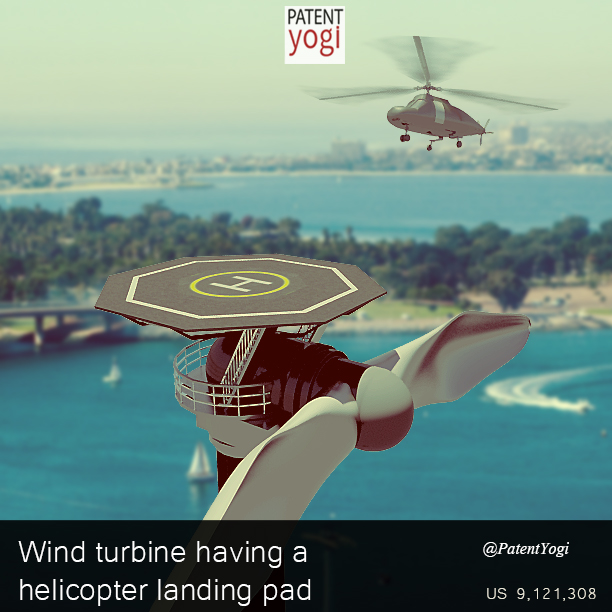
Patent Number – 9,121,308
Patent Title – Wind turbine having a helicopter landing pad
Inventors – Siegfriedsen; Sonke
Assignee: Aerodyn Engineering GmbH (Rendsburg, DE)
Family ID: 1000001310601
Appl. No.: 13/640,155
Filed: December 13, 2011
PCT Filed: December 13, 2011
PCT No.: PCT/DE2011/002112
371(c)(1),(2),(4) Date: November 27, 2012
PCT Pub. No.: WO2012/083925
PCT Pub. Date: June 28, 2012
Abstract
A wind turbine includes a tower, a nacelle rotatably arranged on the tower, and a helicopter landing pad arranged on the nacelle. The wind turbine has a rotor having at most two rotor blades and a locking device for locking the rotor in a position in which the rotor blades extend horizontally, and the helicopter landing pad is arranged on the nacelle in such a way that the cross-section of the upper tower section lies completely within the outer contour of the helicopter landing pad in the top view.
Summary of the Invention
It is therefore the object of the invention to provide a wind turbine, in particular an offshore wind turbine, having a landing facility for helicopters, which influences the statics of the wind turbine as little as possible and exhibits a connecting structure that is as simple and light as possible.
The invention is based on an advantageous combination of several features that, only together, permit a successful implementation of the subject matter of the invention: 1. The wind turbine according to the invention has to be a wind turbine having a two-blade rotor. The wind turbine may only be a wind turbine having at most two rotor blades. In the case of a wind turbine having three rotor blades, there is the problem to be avoided according to the invention, that the rotor blades of the wind turbine, even in the case of a locked rotor, represents a collision risk for the helicopter, in particular for its rotor blades, since always at least one blade of the three-blade rotor extends above the top of the nacelle. 2. The wind turbine must exhibit a locking device using which the two-blade rotor can be locked in a position in which the blades of the two-blade rotor extend in a horizontal position. The locking device can for example have a design as is known from DE 10 2008 063 043 B4. So that the collision risk, mentioned under 1, of the rotor blades of the wind turbine with the rotor blades of the helicopter can be ruled out, it must be possible for the two-blade rotor of the inventive wind turbine to be locked in a horizontal position so that none of the blades extend above the top of the nacelle. A helicopter pilot flying to the inventive wind turbine will thus be presented with a straightforward approach situation without having to worry about structures that extend vertically across the landing pad. 3. Finally the cross-section of the upper tower section in plan view of the inventive wind turbine must lie completely inside the outside contour of the helicopter landing pad. This attribute of the wind turbine ensures that the loads taken up by the helicopter landing pad as also the load of the helicopter landing pad itself can be introduced across the shortest path possible and essentially at right angles into the tower of the wind turbine. This design achieves a high degree of stability of the construction that presents a high level of safety for the landing process and for parking a helicopter on the wind turbine. Since also no booms are required for this, the construction of the helicopter landing pad can also have a light-weight and economic design. A design of the invention is particularly preferred where the helicopter landing pad and the tower are arranged concentrically and the centre of gravity of the helicopter landing pad is arranged essentially vertically above the centre of the tower cross-section.
As is known, the helicopter landing pad is of circular design or designed in particular as a regular octagon. Preferably, it is provided with a mesh for arresting falls that surrounds the helicopter landing pad that can particularly preferably be folded at least in the area facing the rotor of the wind turbine so that the entire surface of the helicopter landing pad can be reduced in the case of non-use during the regular operation of the wind turbine and can be enlarged prior to the approach of a helicopter.
According to a further preferred exemplary embodiment, the helicopter landing pad also exhibits a passage into the interior space of the nacelle of the wind turbine. This passage can be designed for example open or having a hatch that can be locked, it being possible for the hatch to be part of the horizontally extending landing pad.
As an alternative, the design of the hatch can also be such that the hatch does not end in the interior of the nacelle but on the top of the nacelle or of a gangway arranged next to the nacelle, that is to say a walkway leading to a manhole into the interior of the nacelle or into the tower. The gangway can for example be a cooling plant arranged outside the nacelle.
In addition to the general regulations for marking the helicopter landing pad with the letter “H”, illumination of the landing pad, fastening devices for fastening the helicopter while parking on the landing pad, it is also the general regulations in air traffic that have to be complied with, in particular the regulations for the approval of the installation and the operation of helicopter landing places.

